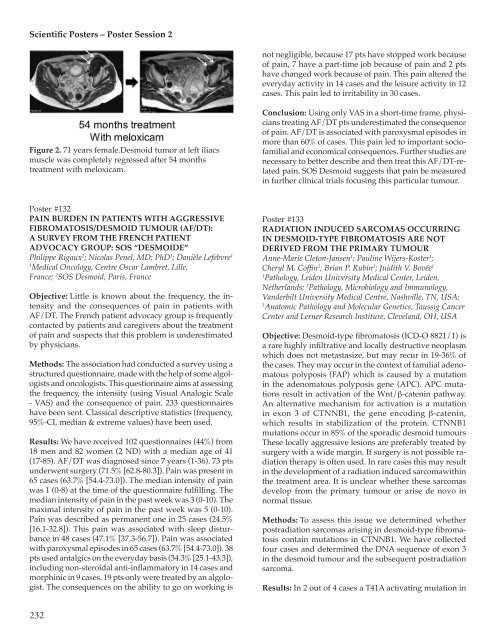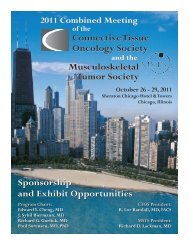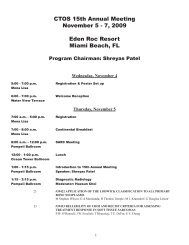207 Poster Session 2 - Connective Tissue Oncology Society
207 Poster Session 2 - Connective Tissue Oncology Society
207 Poster Session 2 - Connective Tissue Oncology Society
Create successful ePaper yourself
Turn your PDF publications into a flip-book with our unique Google optimized e-Paper software.
Scientific <strong>Poster</strong>s – <strong>Poster</strong> <strong>Session</strong> 2not negligible, because 17 pts have stopped work becauseof pain, 7 have a part-time job because of pain and 2 ptshave changed work because of pain. This pain altered theeveryday activity in 14 cases and the leisure activity in 12cases. This pain led to irritability in 30 cases.Figure 2. 71 years female.Desmoid tumor at left iliacsmuscle was completely regressed after 54 monthstreatment with meloxicam.Conclusion: Using only VAS in a short-time frame, physicianstreating AF/DT pts underestimated the consequenceof pain. AF/DT is associated with paroxysmal episodes inmore than 60% of cases. This pain led to important sociofamilialand economical consequences. Further studies arenecessary to better describe and then treat this AF/DT-relatedpain. SOS Desmoid suggests that pain be measuredin further clinical trials focusing this particular tumour.<strong>Poster</strong> #132PAIN BURDEN IN PATIENTS WITH AGGRESSIVEFIBROMATOSIS/DESMOID TUMOUR (AF/DT):A SURVEY FROM THE FRENCH PATIENTADVOCACY GROUP: SOS “DESMOIDE”Philippe Rigaux 2 ; Nicolas Penel, MD; PhD 1 ; Danièle Lefebvre 11Medical <strong>Oncology</strong>, Centre Oscar Lambret, Lille,France; 2 SOS Desmoid, Paris, FranceObjective: Little is known about the frequency, the intensityand the consequences of pain in patients withAF/DT. The French patient advocacy group is frequentlycontacted by patients and caregivers about the treatmentof pain and suspects that this problem is underestimatedby physicians.Methods: The association had conducted a survey using astructured questionnaire, made with the help of some algologistsand oncologists. This questionnaire aims at assessingthe frequency, the intensity (using Visual Analogic Scale- VAS) and the consequence of pain. 233 questionnaireshave been sent. Classical descriptive statistics (frequency,95%-CI, median & extreme values) have been used.Results: We have received 102 questionnaires (44%) from18 men and 82 women (2 ND) with a median age of 41(17-85). AF/DT was diagnosed since 7 years (1-36). 73 ptsunderwent surgery (71.5% [62.8-80.3]). Pain was present in65 cases (63.7% [54.4-73.0]). The median intensity of painwas 1 (0-8) at the time of the questionnaire fulfilling. Themedian intensity of pain in the past week was 3 (0-10). Themaximal intensity of pain in the past week was 5 (0-10).Pain was described as permanent one in 25 cases (24.5%[16.1-32.8]). This pain was associated with sleep disturbancein 48 cases (47.1% [37.3-56.7]). Pain was associatedwith paroxysmal episodes in 65 cases (63.7% [54.4-73.0]). 38pts used antalgics on the everyday basis (34.3% [25.1-43.3]),including non-steroidal anti-inflammatory in 14 cases andmorphinic in 9 cases. 19 pts only were treated by an algologist.The consequences on the ability to go on working is<strong>Poster</strong> #133RADIATION INDUCED SARCOMAS OCCURRINGIN DESMOID-TYPE FIBROMATOSIS ARE NOTDERIVED FROM THE PRIMARY TUMOURAnne-Marie Cleton-Jansen 1 ; Pauline Wijers-Koster 1 ;Cheryl M. Coffin 2 ; Brian P. Rubin 3 ; Juidith V. Bovée 11Pathology, Leiden University Medical Center, Leiden,Netherlands; 2 Pathology, Microbiology and Immunology,Vanderbilt University Medical Centre, Nashville, TN, USA;3Anatomic Pathology and Molecular Genetics, Taussig CancerCenter and Lerner Research Institure, Cleveland, OH, USAObjective: Desmoid-type fibromatosis (ICD-O 8821/1) isa rare highly infiltrative and locally destructive neoplasmwhich does not metastasize, but may recur in 19-36% ofthe cases. They may occur in the context of familial adenomatouspolyposis (FAP) which is caused by a mutationin the adenomatous polyposis gene (APC). APC mutationsresult in activation of the Wnt/β-catenin pathway.An alternative mechanism for activation is a mutationin exon 3 of CTNNB1, the gene encoding β-catenin,which results in stabilization of the protein. CTNNB1mutations occur in 85% of the sporadic desmoid tumoursThese locally aggressive lesions are preferably treated bysurgery with a wide margin. If surgery is not possible radiationtherapy is often used. In rare cases this may resultin the development of a radiation induced sarcomawithinthe treatment area. It is unclear whether these sarcomasdevelop from the primary tumour or arise de novo innormal tissue.Methods: To assess this issue we determined whetherpostradiation sarcomas arising in desmoid-type fibromatosiscontain mutations in CTNNB1. We have collectedfour cases and determined the DNA sequence of exon 3in the desmoid tumour and the subsequent postradiationsarcoma.Results: In 2 out of 4 cases a T41A activating mutation in232






